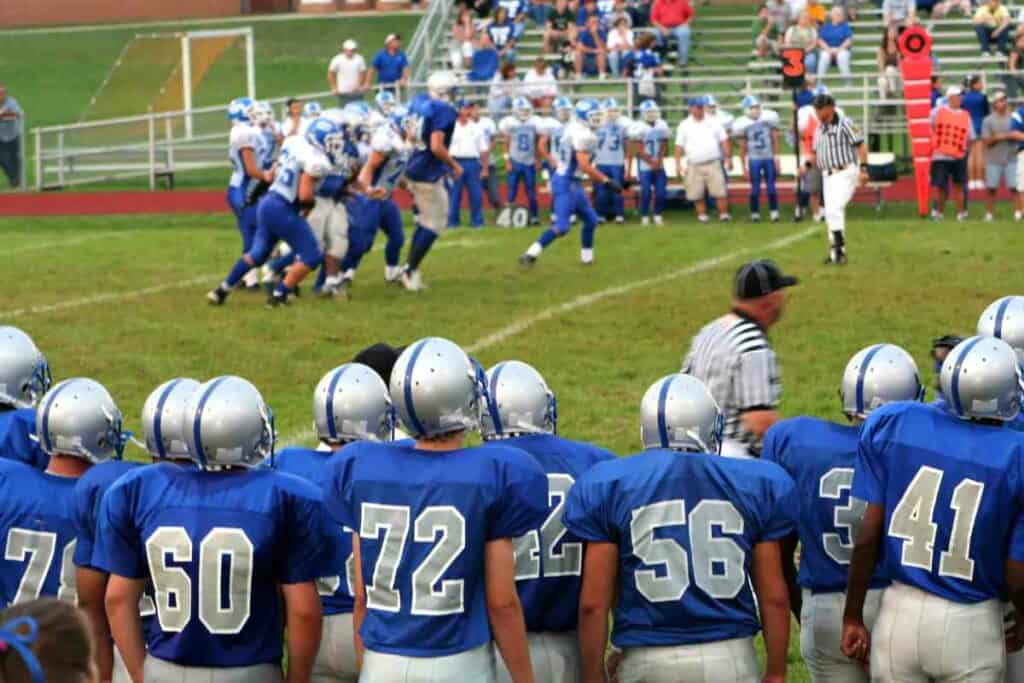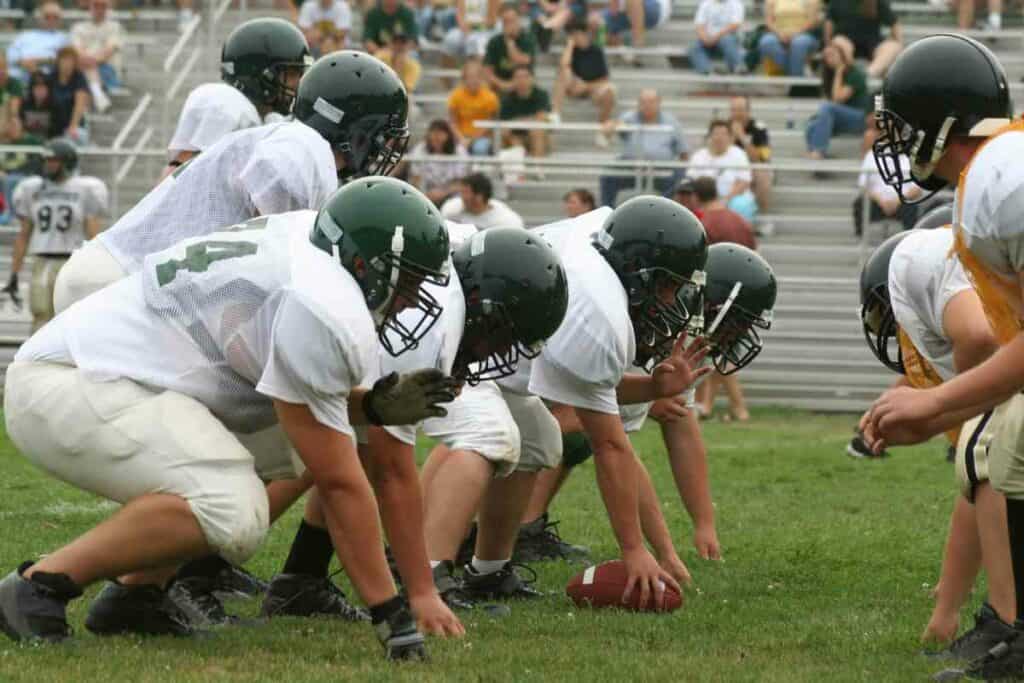How Long is Overtime in High School Football? Duration and Rules Explained
Have you ever wondered what makes high school football games so gripping, especially when they go into overtime? In the United States, the overtime rules set by the National Federation of State High School Associations (NFHS) add an extra layer of excitement and intensity. Imagine this: unlike the NFL’s nail-biting sudden death or the NCAA’s timed periods, high school football’s overtime is a unique showdown. Each team gets a chance to score from the opponent’s 10-yard line, and this thrilling process continues until one team emerges victorious. This ensures a fair and balanced opportunity for both teams to showcase their offense and defense skills.

Related Post! Should I Play High School Football?
How Long is Overtime in High School Football?
The duration of overtime in high school football varies, as there’s no fixed time limit for each period. Instead, teams alternate possessions, each getting a chance to score from a set position on the field. The game continues until one team outscores the other in these alternating rounds.
But what about high school football in Canada? While governed by different organizations, the essence of the overtime rules echoes that of the United States. Each team gets their turn with the ball, striving to outscore their opponent. However, remember that the specifics can vary, so it’s always wise to check the local regulations for the most accurate rules.
Key Takeaways:
- Equal Opportunity Scoring: Each team gets a chance to score from the opponent’s 10-yard line.
- Standardized Rules in the US: While generally consistent, some state-specific variations exist.
- Similar Format in Canada: Offers balanced chances for offense and defense, with some local differences.
Diving Deeper: Understanding High School Football Overtime Rules
When the regular game ends in a tie, that’s when the real drama begins. The overtime period kicks off with a coin toss to decide who gets the ball first. Each team then takes turns trying to score from the opponent’s 25-yard line, a stark contrast to the NFL’s former sudden-death style.

Scoring Dynamics in Overtime
Teams have four downs to either secure a touchdown or a field goal. If they’re still tied after each team’s possession, the game moves into additional overtime periods.
Touchdowns are worth six points, with a chance for a two-point conversion, while field goals score three points. Note that there are no kickoffs in overtime, and extra point attempts are governed by NCAA rules.
Related Post! How Long Are Football Halftimes?
The Strategic Role of Coaches and Officials
Coaches are the masterminds of strategy during overtime, making crucial decisions like opting for a two-point conversion or an extra point.
Meanwhile, officials, including the referee, ensure the rules are followed to the letter. They oversee the coin toss and make sure teams adhere to the procedures, guaranteeing a fair and exciting outcome.
So, next time you’re watching a high school football game that goes into overtime, you’ll appreciate the strategic depth and excitement that these rules bring to the game.
Related Post! How Does High School Football Overtime Work?
State-Specific Variations and Influences
High school football overtime is where the real drama unfolds, but did you know that the overtime rules can vary significantly from state to state? This diversity in rules reflects the influence of both college football and the NFL, making each state’s approach unique.

Overtime Procedures Across States
In states like Florida and Wisconsin, the overtime format mirrors the NCAA. Teams get the opportunity to score from the opponent’s 25-yard line. However, nuances in rules can make a big difference.
For instance, Massachusetts adopts a variation of the California Tiebreaker, starting from the 10-yard line, which can dramatically alter game strategies. Understanding your state’s specific rules is crucial for effective game preparation and coaching decisions.
- Florida: Embraces NCAA-style overtime, starting from the opponent’s 25-yard line.
- Wisconsin: Follows NCAA rules, with potential tweaks in the number of overtime periods.
- Massachusetts: Implements a modified California Tiebreaker, beginning from the 10-yard line.
Influence from Professional and College Football
The NFL and college football significantly shape high school football overtime rules. While many states align with the NCAA format to prep athletes for college, others draw inspiration from the NFL or create unique variations suited to junior high and high school football. This shows how higher levels of the sport influence the experience of younger players.
- NFL’s Sudden Death: Some states might incorporate elements from the NFL’s sudden death overtime.
- College Football: A prevalent influence, with many states mirroring college-level overtime procedures.
Always check your state’s specific regulations for a clear understanding of the overtime rules and their influences.
Overtime Strategies and Player Dynamics
Overtime in high school football isn’t just extra playtime; it’s a high-stakes phase demanding precision and calm from coaches and players.

Coaching Tactics in Overtime
- Offense: Coaches often rely on tried-and-true plays, avoiding complex strategies that risk miscommunication.
- Defense: Understanding the opponent’s tendencies is key. Coaches may use timeouts strategically and adjust formations to disrupt the opponent’s offensive flow.
Player Execution and Mindset
- Skill and Nerve: Players must exhibit top-notch skills and maintain composure, executing plays precisely and avoiding penalties.
- Injuries: The intensity of overtime increases injury risks. Players need to be extra cautious, and coaches should be ready to adapt if key players are sidelined.
High school football overtime is a test of preparation, adaptability, and composure for both coaches and players. The actions taken in these critical moments often highlight the importance of strategic planning and mental fortitude in the face of intense pressure. Whether you’re a player, coach, or a fan, understanding these nuances makes every overtime moment more exhilarating. Are you ready to dive into the next high-stakes overtime scenario?
Frequently Asked Questions About High School Football Overtime
What are the basic rules of high school football overtime?
In high school football, overtime typically involves each team getting a chance to score from a set position on the field, often the opponent’s 10 or 25-yard line, depending on the state. Teams alternate possessions, and the game continues until one team scores more points in the overtime period.
How does high school football overtime differ from college and NFL?
Unlike the NFL’s sudden death format or the NCAA’s timed periods, high school football overtime usually gives each team an equal opportunity to score, starting from a predetermined position on the field. This can vary by state, with some adopting rules similar to the NCAA.
Do all states follow the same overtime rules in high school football?
No, overtime rules in high school football can vary significantly from state to state. While some states follow rules similar to the NCAA, others have unique variations or adopt different formats like the California Tiebreaker.
What is the most common strategy used by coaches during high school football overtime?
Coaches typically focus on reliable, well-practiced plays during overtime. Offensive strategies often revolve around consistent gains, while defensive tactics are geared towards disrupting the opponent’s rhythm. Coaches also need to be adept at managing player fatigue and making quick strategic decisions.
How do players prepare for the pressure of overtime in high school football?
Players prepare for overtime by focusing on mental and physical endurance, precision in executing plays, and maintaining composure under pressure. Regular practice of high-pressure scenarios and a strong emphasis on teamwork and communication are crucial for success in overtime situations.
Are there any special considerations for player safety during overtime?
Yes, the intensity of overtime can increase the risk of injuries. Coaches and players need to be vigilant about safety, ensuring proper warm-ups and being mindful of fatigue. It’s also important for coaches to have contingency plans if key players are injured and to encourage players to communicate any health concerns immediately.
Can a high school football game end in a tie?
This depends on the state’s specific rules. In many states, high school football games continue in overtime until a winner is determined, but some states may allow games to end in a tie if neither team scores in the overtime period or due to specific regulations or conditions.
